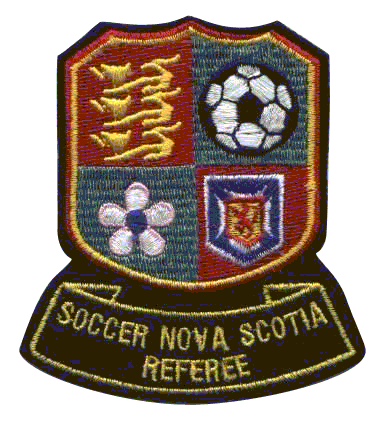
|
Training & Registration | |
|
Resources | |
|
FAQ's | |
|
About the HDSRA |

1.
Do you know the official uniform for a NS referee? Nova
Scotia Referees (other than first year officials) must have an alternate colour
shirt if the game demands it. The first choice alternate is yellow, then
red. If all Officials do not have the same alternate colour, then the
Centre Referee will wear the alternate and the Assistants will wear black.
For National and televised games, all Officials shall wear shirts of the
same colour. The
badge, issued by Soccer Nova Scotia, shall be worn on the left breast area of the shirt.
2.
Do you know what your responsibilities are, when you are offered a game? 3.
Do you know the maximum number of games you may referee each day?
When officiating, all
referees shall wear the official uniform which is a black shirt, black shorts
and black socks.
No more than 180 minutes of the 360 may be as centre referee.
For 11-a-side matches, officials may not act as centre referee for more than two consecutive matches.
4.
Do you know when you might be in a conflict of interest?
Competitive games involving a team in the same age and gender division in the same league to which the referee is directly affiliated as a player, registered coach or manager.
Competitive
games in which an immediate member of his/her family (by marriage or common law)
is a registered player or coach. An immediate member of the family is a parent,
a spouse, a son or daughter, a brother or sister.
Provincial
championship game involving a team or club to which the referee is directly
affiliated as a player, a registered coach or manager, an elected Executive or
Board member.
5.
Do you know when you are required to report to the field?
Officials
must report to the field ready to officiate and conduct pre-game activities
(field inspection, personal equipment, instructions to assistant referees,
players’ equipment, game ball, starting time) as directed by their regional
referee committee but no less than:
|
15 minutes for Tier II, Senior B, Senior C and 7-a-Side Games | |
|
30 minutes for Tier I and Senior A | |
| 60 minutes for televised games |
6. Do you know when a dismissal (formerly misconduct) report must be filed and how to fill one in?
In the event of serious foul play or violent conduct or misconduct toward the match referee or assistant referees, the centre referee shall, within 24 hours of the conclusion of the game, submit a copy of the Soccer Nova Scotia Dismissal Report to Soccer Nova Scotia. (for more information, click here, then scroll to find module on writing dismissal forms)
7.
What about eye glasses, headwear, footwear and jerseys?
Eye Glasses:
Laws 4 and 5 apply: "a player must not use equipment or wear anything that
is dangerous to himself or another player"; and "the referee ensures
that the players' equipment meets the requirements of Law 4".
Hats:
no hats are allowed on the field of play, except for goalkeepers using
one as an eye
Footwear
Jerseys
Disciplinary
actions
The player(s)
will be instructed to remove the dangerous item. A player who, after
having been told to remove jewellery, wears it again will receive a caution.
8. Can players wear jewelry?
The rule
of thumb should be ‘if it can be seen, it’s a problem’.
Earrings: no earrings of any kind are acceptable. The practice of taping
is no longer
Facial rings: any kind of jewellery around the eyes, nose or any other
part of the face must be
Bracelets: all bracelets (including metal, rope, fabric …) must be
removed.
Medic Alert bracelets: may be worn but must be covered or padded in order
to be safe for all
Necklaces: all necklaces must be removed.
Body piercing; any body piercing not visible to the referee is not of
concern. Should the
Watches: players are not allowed to wear any kind of watches.
Beaded Hair: if a player is wearing hair beads the hair must be tied in a
bun or covered by a
Wedding rings: must be removed. The sole exception is a smooth wedding
band which the
9. Can players wear knee braces?
Any
support must be safe for all players, and adequately padded if necessary.
10.
Can players wear casts?
Players
wearing a soft cast will be permitted to play if the cast does not present a
danger to